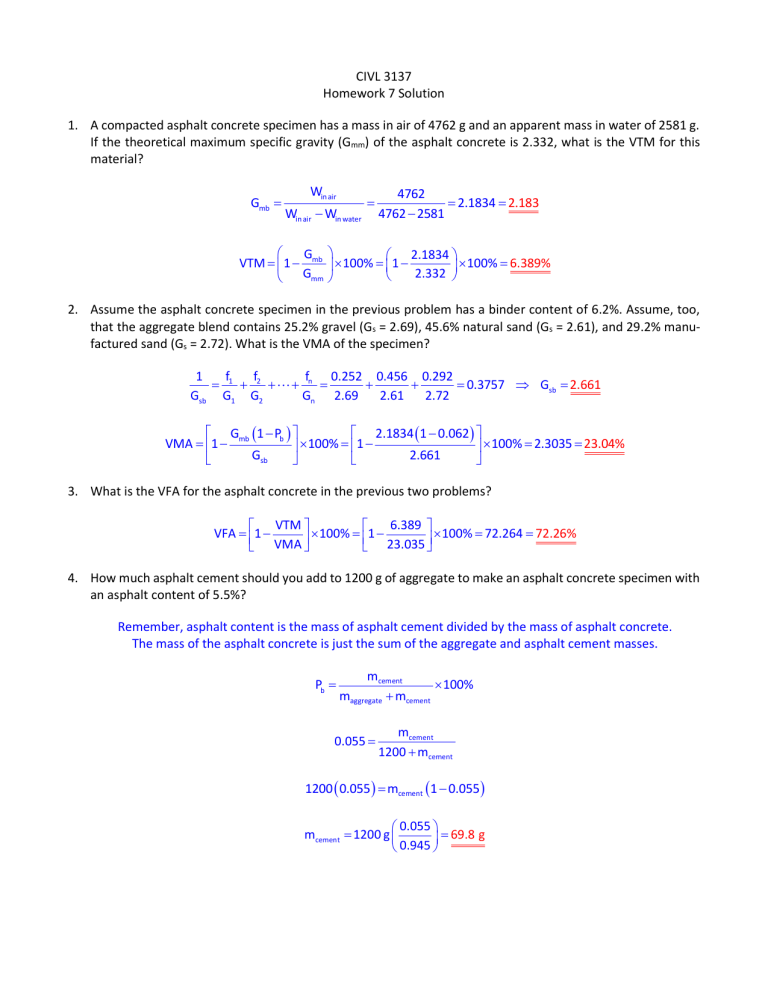
CIVL 3137 Homework 7 Solution 1. A compacted asphalt concrete specimen has a mass in air of 4762 g and an apparent mass in water of 2581 g. If the theoretical maximum specific gravity (Gmm) of the asphalt concrete is 2.332, what is the VTM for this material? Gmb Win air Win air Win water 4762 2.1834 2.183 4762 2581 G 2.1834 VTM 1 mb 100% 1 100% 6.389% 2.332 Gmm 2. Assume the asphalt concrete specimen in the previous problem has a binder content of 6.2%. Assume, too, that the aggregate blend contains 25.2% gravel (Gs = 2.69), 45.6% natural sand (Gs = 2.61), and 29.2% manufactured sand (Gs = 2.72). What is the VMA of the specimen? f f f 1 0.252 0.456 0.292 1 2 n 0.3757 Gsb 2.661 Gsb G1 G2 Gn 2.69 2.61 2.72 G 1 Pb 2.1834 1 0.062 VMA 1 mb 100% 1 100% 2.3035 23.04% Gsb 2.661 3. What is the VFA for the asphalt concrete in the previous two problems? VTM 6.389 VFA 1 100% 1 100% 72.264 72.26% VMA 23.035 4. How much asphalt cement should you add to 1200 g of aggregate to make an asphalt concrete specimen with an asphalt content of 5.5%? Remember, asphalt content is the mass of asphalt cement divided by the mass of asphalt concrete. The mass of the asphalt concrete is just the sum of the aggregate and asphalt cement masses. Pb mcement 100% maggregate mcement 0.055 mcement 1200 mcement 1200 0.055 mcement 1 0.055 0.055 mcement 1200 g 69.8 g 0.945 5. Using the attached viscosity-temperature chart, determine the range of allowable mixing temperatures and the range of allowable compaction temperatures for this asphalt cement. Compaction Range: 313-323°F Mixing Temp Range: 337-349°F 6. The table below contains the average results from a series of 15 Marshall tests (3 pats at each of 5 different asphalt contents) using a dense-graded aggregate blend with a nominal maximum aggregate size of 25 mm (1"). Plot the test results in Excel and establish the relationships between the test results and asphalt content. Unit Weight (pcf) Stability (lb) Flow Air Voids (%) VMA (%) VFA (%) 5.5 147.4 2450 12.1 5.4 15.2 64.5 Asphalt Content (%) 6 6.5 7 148.0 148.3 148.2 2600 2500 2200 13.0 13.7 14.1 4.7 4.0 3.3 14.9 14.7 14.8 68.5 72.8 77.7 7.5 147.9 1790 14.3 2.9 15.3 81.0 7. Use the plots from the previous question to determine the optimum asphalt content based on the Asphalt Institute method. Be sure to show your work. No equation, no credit. Max Density Max Stability 4% Air Voids 6.7% 6.0% 6.5% AC 6.4% 3 8. Use the plots from the previous two questions to estimate the stability, flow, VTM, VMA and VFA of an asphalt mix with the optimum asphalt content. State whether each value meets the Asphalt Institute requirements for a high-traffic pavement. Stability: 2513 > 1800 (met) Flow: 8 < 13.5 < 16 (met) VTM: 3% < 4.2% < 5% (met) VMA: 14.7% < 15% (not met) VFA: 65% < 72% < 75% (met)


